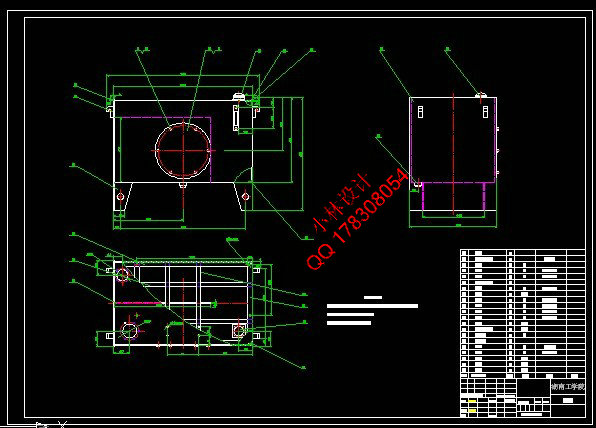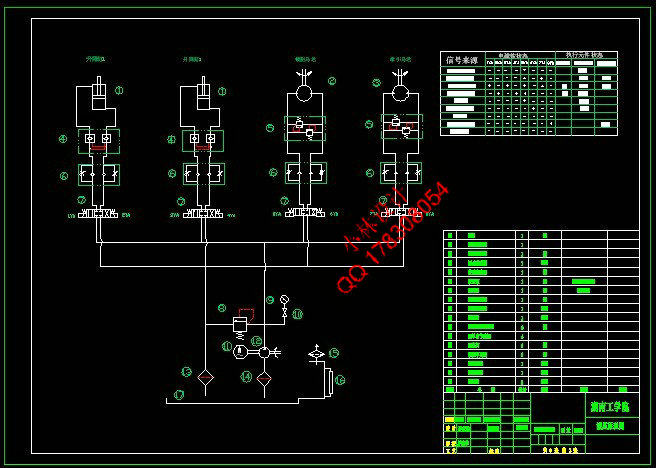|
设计描述:
文档包括:
word说明书一份,共49页,约26000字
CAD版本图纸,共7张
摘 要
随着陆地上的矿产资源不断被开发利用,深海采矿的战略意义越来越重要。本文设计了一台用于模拟深海采矿的螺旋滚筒破碎试验台。其设计内容主要包括该设备的液压系统设计及其电气系统设计。液压系统设计主要有系统原理设计、元件选型、油路块的设计、液压泵站的设计以及实现该系统功能的电气控制系统设计。其中液压控制元件选择了叠加阀, 为了防止螺旋滚筒在切割工料时因矿石的凸凹不平产生倾斜,进而产生严重的偏载,本系统采用了双单向节流阀以达到液压缸的同步控制。电气控制系统采用较为简单的继电器控制,最后本文还合理设计了液压泵站。
关键词: 深海采矿; 螺旋滚筒; 液压系统; 电气控制
ABSTRACT
Along with the exploitation of mining resource on the land, the stratagetic meaning of the deep-sea mining is becoming more and more important. So I design a set of crash experimental bench with helical cutting dram .The experimental bench is used to simulate mining in deep sea. The content includes design of hydraulic system and electrical system of this experimental bench. The design of hydraulic system contains five parts. They are theoretical design of the system , selecting hydraulic elements, oil route block design , pumping station design and the electric controlling system design. The system selects superimposing valves as hydraulic control elements. In the cutting , the helical cutting drum will lean for the rugosity of the ore. The both-unilateralism throttles will solve the problem by in-phase control of the hydraulic cylinders. The electric controlling system selects relay control. At last, I design the hydraulic pumping station reasonablely.
Key words: Deep-sea Mining;Helical Cutting Drum;Hydraulic System;
Electric Control
目 录
1 绪论…………………………………………………………………………1
1.1文献综述……………………………………………………………………1
1.1.1课题研究背景…………………………………………………………1
1.1.2 深海采矿技术的发展…………………………………………………1
1.1.3课题研究的意义………………………………………………………2
1.1.4本文设计的内容………………………………………………………2
1.2 液压技术简介…………………………………………………………3
1.2.1液压系统概述…………………………………………………………3
1.2.2液压传动的优点 ………………………………………………………4
1.2.3 液压技术的缺点………………………………………………………5
1.3 本章小结……………………………………………………………………6
2 液压系统设计………………………………………………………………7
2.1液压系统设计要求及有关设计参数 ………………………………………7
2.1.1破碎试验台液压系统要求 ……………………………………………7
2.1.2 液压系统设计参数 ……………………………………………………7
2.2制定系统方案和系统原理图 ……………………………………………7
2.2.1制定系统方案…………………………………………………………8
2.2.2 拟订液压系统图………………………………………………………8
2.2.3 液压原理图的分析设计……………………………………………11
2.3 液压执行元件载荷力和载荷转矩计算……………………………………13
2.3.1 升降缸的载荷计算…………………………………………………13
2.3.2 截割部液压马达载荷转矩计算……………………………………14
2.3.3 牵引部液压马达载荷转矩计算……………………………………14
2.4 液压系统主要参数计算……………………………………………………14
2.4.1 初选系统工作压力…………………………………………………14
2.4.2 计算升降缸的主要结构尺寸………………………………………15
2.4.3 计算液压马达的排量………………………………………………16
2.4.4 计算液压执行元件实际工作压力…………………………………16
2.4.5 液压执行元件实际所需的流量……………………………………17
2.5 液压元件的选择……………………………………………………………17
2.5.1 液压泵的选择…………………………………………………………17
2.5.2 液压马达的选择………………………………………………………18
2.5.3 液压阀的选择…………………………………………………………18
2.5.4 电动机功率的确定……………………………………………………19
2.5.5 确定油箱的有效容积…………………………………………………20
2.5.6 管道尺寸的确定 ……………………………………………………20
3 油路块设计………………………………………………………………21
3.1 液压元件的联接方式……………………………………………………21
3.1.1管式联接………………………………………………………………21
3.1.2板式联接………………………………………………………………21
3.1.3法兰联接………………………………………………………………21
3.2 油路块的设计准则…………………………………………………………21
3.2.1块体结构及其结构尺寸的确定………………………………………21
3.2.2油路块内油道孔设计 ………………………………………………22
3.3 油路块的具体设计 ………………………………………………………23
3.3.1 油路块的总体结构设计………………………………………………23
3.3.2 输出油孔的设计……………………………………………………24
3.3.3 进回油孔的设计………………………………………………………25
3.3.4 工艺孔的设计…………………………………………………………25
4 电气控制系统设计………………………………………………………27
4.1 电气控制系统的要求和内容 ……………………………………………27
4.1.1电气控制系统的要求 ………………………………………………27
4.1.2 电气控制系统的内容 ………………………………………………28
4.2 电气控制原理图的设计 ………………………………………………28
4.2.1 主电路的设计 ………………………………………………………28
4.2.2控制电路的设计 ……………………………………………………28
4.2.3辅助电路的设计………………………………………………………29
4.2.4总体电气原理图………………………………………………………29
5 液压泵站设计分析 ………………………………………………………30
5.1电机泵组设计与选型………………………………………………………30
5.1.1液压泵的分析计算与选型 …………………………………………30
5.1.2 电机的选型……………………………………………………………31
5.2 液压油箱的设计计算………………………………………………………31
5.2.1液压油箱的设计要求…………………………………………………32
5.2.2 液压油箱容积的计算分析…………………………………………32
5.2.3 液压油箱附件的选型………………………………………………33
5.3液压的热平衡校核………………………………………………………34
5.3.1 液压油箱发热功率计算……………………………………………34
5.3.2 液压油箱热平衡校核………………………………………………34
5.4 本章小结……………………………………………………………………35
6 技术经济分析……………………………………………………………36
6.1技术经济分析的目的………………………………………………………36
6.2技术经济分析………………………………………………………………37
参考文献……………………………………………………………………………39
致谢……………………………………………………………………………40
附录……………………………………………………………………………41
| 









